What is Sateen? Fabric, Weave, Uses and Care Guide
Are you considering new bedding or perhaps fabric for a sewing project, and find yourself wondering about sateen? You’ve likely seen the term, often associated with luxury and softness, but what exactly is it? Perhaps you’re confused about the difference between sateen and satin, or unsure if sateen is the right choice for your needs. Choosing the wrong fabric can lead to discomfort – sheets that are too warm, a garment that doesn’t drape well, or fabric that doesn’t hold up to everyday use.
This comprehensive guide to sateen fabric will answer all your questions. You’ll gain a clear understanding of what defines sateen, its unique weave structure, the common fibers used, and how these factors influence its appearance, texture, and durability. We’ll explore its many uses, weigh its pros and cons, provide detailed care instructions, and compare it to similar fabrics like satin and percale. Armed with this knowledge, you’ll be able to confidently make informed decisions when buying sateen products or selecting sateen fabric for your next creation.
1. Unveiling the secrets of sateen
Sateen fabric is often described as luxurious, soft, and smooth, with a subtle sheen that adds a touch of elegance to any project. It’s a popular choice for bedding, clothing, and even home décor, prized for its comfortable feel and attractive appearance. But what sets sateen apart from other fabrics? The secret lies in its unique weft-faced weave.
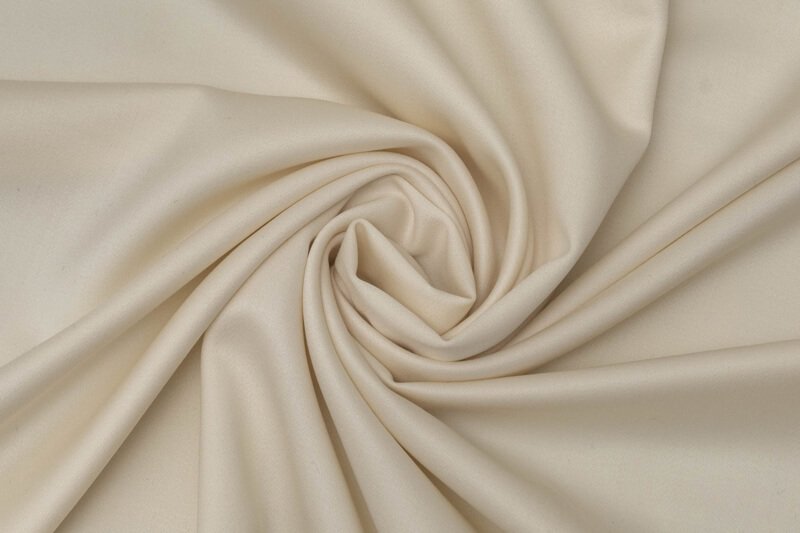
2. Defining sateen: It’s all about the weave
The defining characteristic of sateen is its weave structure. While the fiber content can vary (though cotton is most common), it’s the specific way the yarns are interlaced that makes a fabric “sateen.”
2.1 The weft-faced wonder: Understanding the sateen weave
The sateen weave is a variation of the satin weave, but with a crucial difference: it is weft-faced. To understand this, let’s define the key terms:
- Warp yarns: These are the yarns that run vertically (lengthwise) on the loom, held taut under tension.
- Weft yarns: These are the yarns that run horizontally (crosswise) on the loom, weaving over and under the warp yarns.
In a sateen weave, the weft yarns “float” over multiple warp yarns before going under a single warp yarn. The most common sateen weave pattern is four-over-one-under. This means that a weft yarn floats over four warp yarns, and then goes under one warp yarn. This pattern then repeats across the fabric.
This “floating” of the weft yarns is what creates sateen’s characteristic smooth, lustrous surface. Because a greater proportion of the weft yarns are visible on the surface, and these weft yarns are relatively uninterrupted, they reflect light more uniformly. However, because it’s the weft yarns that are floating (unlike satin, where it’s the warp yarns), the light reflection is more diffused, resulting in a subtle sheen rather than a high gloss.
To visualize this, compare it to a simple plain weave (like that used in percale). In a plain weave, the weft yarns go over one warp yarn, then under the next, in a simple one-over-one-under pattern. This creates a much more matte and textured surface. The sateen weave, with its floats, creates a much smoother surface.
2.2 Sateen vs. satin: A crucial distinction
The key difference is that sateen is weft-faced weave, while satin is warp-faced.
3. Fiber content: Cotton is king (but not the only option)
While the weave defines sateen, the fiber content can vary. However, sateen is most commonly and traditionally associated with cotton.
3.1 Cotton sateen: The soft and durable choice
Cotton sateen is by far the most popular type of sateen, and for good reason. Cotton offers a combination of desirable properties that make it ideal for this weave:
- Softness: Cotton fibers are naturally soft, and the sateen weave further enhances this softness, creating a fabric that feels luxurious against the skin.
- Breathability: Cotton is a breathable fiber, allowing for good air circulation. This makes cotton sateen a comfortable choice for bedding and clothing, especially in warmer climates.
- Durability: Cotton is a relatively strong and durable fiber, and the sateen weave, while smooth, is still quite robust.
- Easy care: Most cotton sateen fabrics are machine-washable and dryable, making them a practical choice for everyday use.
However, not all cotton is created equal. The quality of the cotton used in sateen significantly impacts its overall feel and performance. High-quality cotton sateen often uses long-staple cotton varieties, such as:
- Egyptian cotton: Renowned for its extra-long, fine fibers, which create an exceptionally soft, smooth, and durable sateen.
- Pima cotton: Another type of extra-long-staple cotton, also prized for its softness, strength, and luster.
These long-staple cottons produce a sateen that is noticeably softer, smoother, and more durable than sateen made with short-staple cotton.
Many cotton sateens are also mercerized. This is a treatment process that involves exposing the cotton fibers to a caustic solution (usually sodium hydroxide) under tension. This treatment permanently alters the structure of the cotton fibers, resulting in several benefits:
- Increased luster: Mercerization gives the cotton a more pronounced sheen, enhancing sateen’s natural luster.
- Increased strength: The treatment makes the cotton fibers stronger and more durable.
- Improved dye uptake: Mercerized cotton absorbs dye more readily, resulting in richer, more vibrant colors that are less prone to fading.
3.2 Other sateen fibers: Less common, but possible
While cotton is the dominant fiber for sateen, it can also be made from other fibers, although these are less common:
- Rayon: Sateen made from rayon can have a very smooth, silky feel and a good drape. However, rayon is generally less durable than cotton and may require more delicate care.
- Blends: Sometimes, sateen is made from blends of cotton with other fibers, such as polyester or rayon. These blends are often designed to combine the benefits of different fibers, such as the softness of cotton with the wrinkle resistance and durability of polyester. However, the properties of blended sateens can vary widely depending on the specific fiber proportions.
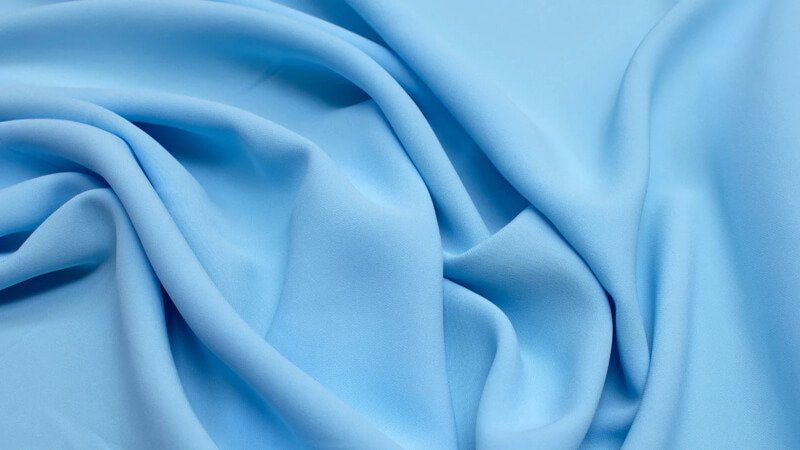
4. Types of cotton sateen
- Egyptian cotton sateen: Made from high-quality Egyptian cotton fibers, known for exceptional softness and durability.
- Organic cotton sateen: Produced from organically grown cotton, free from harmful chemicals and pesticides, making it eco-friendly.
- Stretch cotton sateen: Blended with a small percentage of elastane or spandex for added stretch and flexibility.
- Cotton Satin Deco: Heavy woven fabric with a satin binding, giving it a glossy front and matte back, suitable for printing.
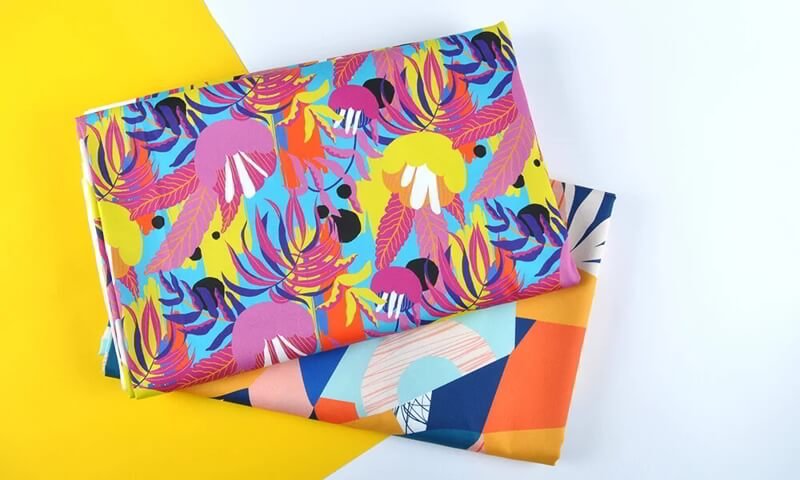
5. The characteristics of sateen: What makes it special?
The combination of the sateen weave and the (typically) cotton fiber content gives sateen its distinctive characteristics.
5.1 Softness and smoothness: A luxurious feel
Sateen is renowned for its exceptionally soft and smooth texture. This luxurious feel is a direct result of the weft-faced sateen weave. The floating weft yarns create a surface with fewer interlacing points, minimizing friction and resulting in a smooth, almost silky hand feel. This makes sateen incredibly comfortable against the skin, making it a popular choice for bedding and clothing.
5.2 Subtle sheen: A gentle luster
Unlike the high-gloss shine of satin, sateen has a subtle luster or glow. The weft-faced weave diffuses light more than the warp-faced satin weave, creating a softer, more matte appearance. This subtle sheen adds a touch of elegance without being overly flashy.
5.3 Drape: Flowing and elegant
Sateen has good drape, meaning it falls and folds gracefully. This property makes it suitable for both bedding (where it drapes nicely over the bed) and clothing (where it creates a flattering silhouette). While not as fluid and flowing as satin, sateen’s drape is still elegant and adds a touch of sophistication to garments.
5.4 Durability: Strong and long-lasting
Sateen, particularly cotton sateen, is a durable fabric. The relatively tight weave and the inherent strength of cotton fibers (especially long-staple cotton) make it resistant to wear and tear. This durability makes sateen a good choice for items that will see frequent use and washing, such as bedding and everyday clothing.
5.5 Breathability: Comfort in all seasons
Cotton sateen is known for its breathability. Cotton is a naturally breathable fiber, allowing for good air circulation. This helps to regulate temperature and prevent overheating, making cotton sateen a comfortable choice for bedding and clothing in a variety of climates. However, it’s worth noting that sateen’s tighter weave can make it slightly warmer than some other cotton weaves, like percale.
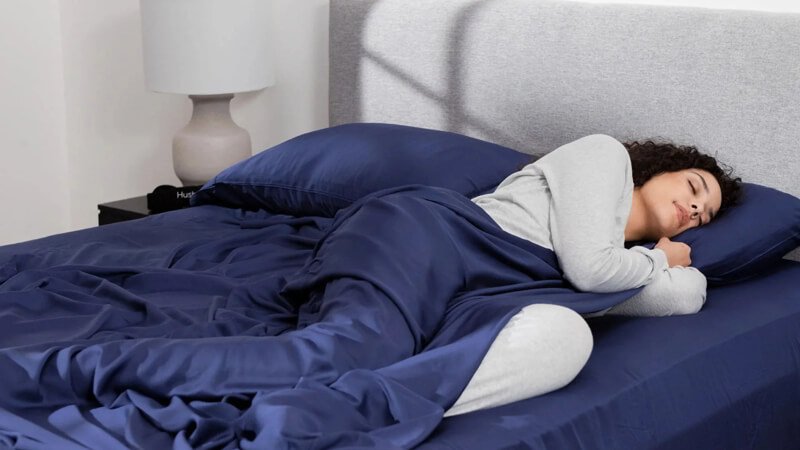
5.6 Wrinkle resistance: Relatively easy care
Sateen is considered relatively wrinkle-resistant, especially compared to fabrics like linen or rayon. However, it’s not completely wrinkle-free. The sateen weave and the cotton fibers themselves have some natural resistance to creasing, but wrinkles can still occur. Fortunately, sateen is generally easy to iron if needed.
6. Common uses of sateen: From bedding to apparel
Sateen’s versatile properties make it suitable for a wide range of applications.
6.1 Bedding: The sateen sweet spot
Sateen is perhaps best known for its use in bedding. It’s an incredibly popular choice for sheets, pillowcases, duvet covers, and shams. Its popularity stems from several key factors:
- Softness and comfort: The smooth, soft texture of sateen feels luxurious against the skin, making for a comfortable and inviting sleep experience.
- Luxurious feel: The subtle sheen and elegant drape of sateen add a touch of luxury to the bedroom.
- Good drape: Sateen sheets drape beautifully over the bed, creating a neat and inviting appearance.
- Durability: Cotton sateen is durable enough to withstand regular use and washing.
- Breathability: Cotton sateen allows for good air circulation, helping to regulate temperature and prevent overheating during sleep.
6.2 Clothing: Versatile and stylish
Sateen is also a versatile fabric for clothing, offering a blend of comfort, style, and (in the case of cotton sateen) relative ease of care. It’s used in a variety of garments, including:
- Dresses and skirts: Sateen’s drape and subtle sheen make it a good choice for dresses and skirts where a touch of elegance is desired.
- Blouses and shirts: Cotton sateen can be used to create comfortable and stylish blouses and shirts.
- Jackets and linings: Sateen can be used as a lining fabric for jackets and coats, providing a smooth and luxurious feel. It can also be used for lightweight jackets themselves.
- Evening wear: While not as commonly used as satin for very formal gowns, sateen can be used for evening wear where a less glossy, more understated elegance is preferred.
- Lingerie and sleepwear: The softness and smoothness of sateen make it a comfortable choice for lingerie and sleepwear.
6.3 Home decor: Adding a touch of luxury
Beyond bedding and clothing, sateen can also be found in home décor applications:
- Curtains and draperies: Sateen’s drape and subtle sheen make it a good choice for curtains and draperies, adding a touch of elegance to a room.
- Upholstery: Sateen can be used for upholstery, particularly for pieces that don’t see extremely heavy use. Its smoothness and durability make it a comfortable and attractive option.
- Cushion covers: Sateen can be used to create decorative cushion covers, adding a touch of luxury and visual interest.
7. The pros and cons of sateen: Weighing the options
Like any fabric, sateen has both advantages and disadvantages.
7.1 Advantages of sateen
- Soft and luxurious feel: The weft-faced weave and (often) cotton fibers create an exceptionally soft and smooth texture.
- Subtle luster/sheen: Offers a touch of elegance without being overly shiny.
- Good drape: Falls and folds gracefully, making it suitable for a variety of applications.
- Durable (especially cotton sateen): Withstands wear and tear better than more delicate fabrics like satin.
- Relatively easy to care for (often machine washable): Most cotton sateens can be machine washed and dried.
- Versatile: Used in a wide range of applications, including bedding, clothing, and home décor.
- Breathable (especially cotton sateen): Allows for good air circulation, promoting comfort.
- Relatively wrinkle-resistant: Less prone to wrinkling than some other fabrics.
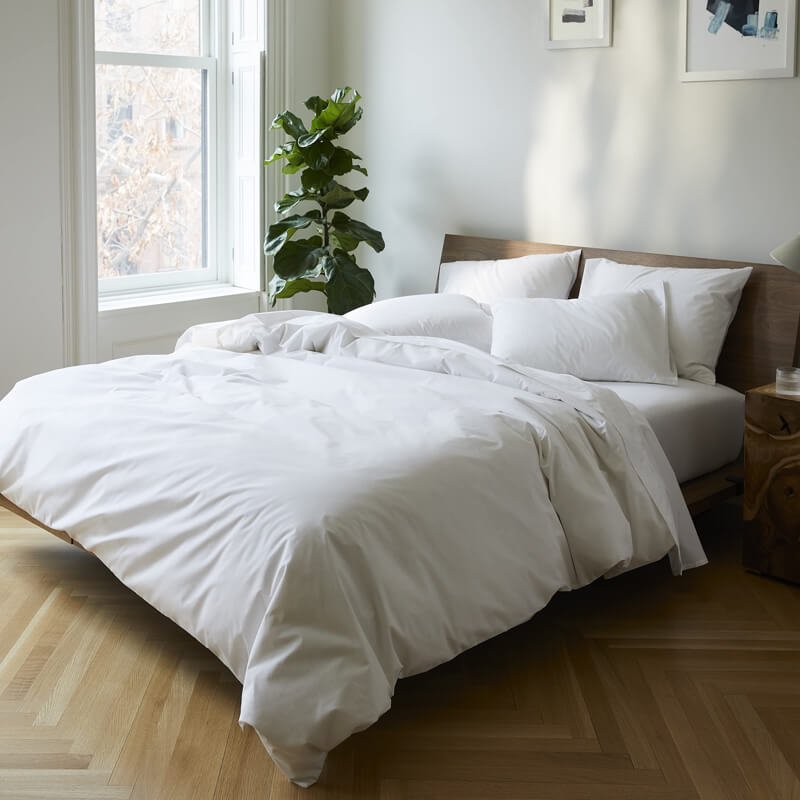
7.2 Disadvantages of sateen
- Can wrinkle: While relatively wrinkle-resistant, sateen is not completely wrinkle-free and may require ironing, especially after washing.
- May trap heat: While cotton sateen is breathable, its tighter weave can make it slightly warmer than some other cotton weaves (like percale). This may be a disadvantage for very hot sleepers.
- Can be more susceptible to pilling: Than some other weaves, particularly if made with lower-quality cotton or subjected to a lot of friction.
- May not be as durable as some other fabrics: While more durable than satin, sateen may not be as durable as very robust fabrics like twill or canvas.
- Some manufacturers may use chemical finishes: While not inherent to sateen itself, some manufacturers may use chemical finishes to enhance wrinkle resistance or sheen. If you’re concerned about this, look for certifications like Oeko-Tex.
8. Caring for sateen: Keeping it looking its best
Proper care is essential for maintaining the beauty and longevity of your sateen items.
8.1 Washing sateen
- Most cotton sateen is machine washable, making it a relatively easy-care fabric.
- Use a gentle cycle with cold or warm water. Avoid hot water, which can damage the cotton fibers and cause shrinkage.
- Use a mild detergent formulated for delicate fabrics.
- Avoid using bleach or fabric softeners. Bleach can weaken the fibers and fade colors, while fabric softeners can coat the fibers, reducing their absorbency and potentially affecting the sheen.
8.2 Drying sateen
- Tumble dry on low heat or line dry. High heat can damage the fibers and cause shrinkage.
- Remove promptly from the dryer to minimize wrinkles.
8.3 Ironing sateen
- If ironing is needed, use a medium heat setting on your iron.
- It’s best to iron sateen on the reverse side of the fabric (the duller side) to protect the sheen and prevent any potential scorching or damage to the more visible surface.
8.4 General care tips
Always check the care label on your sateen item for specific instructions. Different manufacturers may have slightly different recommendations.
9. Sateen vs. other fabrics: Making comparisons
To further clarify sateen’s unique characteristics, let’s compare it to other common fabrics:
9.1 Sateen vs. satin
This is the most common comparison, and the most important distinction to understand.
- Weave: Sateen is weft-faced (weft yarns float over warp yarns). Satin is warp-faced (warp yarns float over weft yarns). This is the defining difference.
- Fiber: Sateen is typically made with spun yarns (most commonly cotton, but also rayon or blends). Satin is typically made with filament fibers (silk, polyester, nylon, rayon).
- Sheen: Sateen has a subtle luster or sheen, a soft glow. Satin has a high gloss, very shiny appearance.
- Durability: Sateen is generally more durable and resistant to wear and tear. Satin is more delicate and prone to snagging.
- Care: Sateen is often machine washable. Satin often requires hand washing or dry cleaning, especially if it’s silk.
- Feel: Sateen is soft and cozy. Satin is smooth and slick.
9.2 Sateen vs. percale
Percale is another popular fabric for bedding, often compared to sateen.
- Weave: Sateen is a sateen weave (weft-faced, typically four-over-one-under). Percale is a plain weave (one-over-one-under).
- Feel: Sateen is soft and smooth. Percale is crisp and cool to the touch.
- Sheen: Sateen has a subtle luster. Percale has a matte finish (no sheen).
- Breathability: Percale is generally considered more breathable than sateen, making it a popular choice for hot sleepers. Sateen can be slightly warmer.
- Wrinkle resistance: Sateen tends to be slightly more wrinkle-resistant than percale.
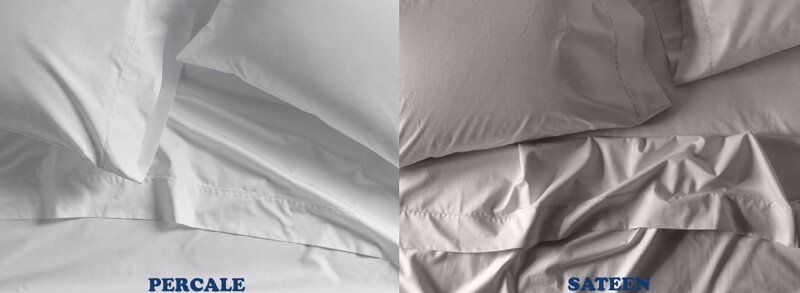
9.3 Sateen vs. Egyptian cotton
This comparison is a bit tricky because it’s comparing a weave (sateen) to a fiber type (Egyptian cotton).
- Egyptian cotton refers to the fiber itself. It’s a type of extra-long-staple cotton grown in Egypt, known for its exceptional softness, strength, and durability.
- Sateen refers to the weave structure.
You can have Egyptian cotton sateen – meaning the fabric is made from Egyptian cotton fibers and woven in a sateen weave. This combines the benefits of both the high-quality fiber and the luxurious weave.
However, it’s important to note that not all Egyptian cotton is sateen, and not all sateen is made from Egyptian cotton. Traditionally, Egyptian cotton is often used to make percale fabric (plain weave).
10. Buying sateen: What to look for
When shopping for sateen products (bedding, clothing, or fabric), consider these factors:
10.1 Fiber content: Aim for 100% cotton (long-staple if possible)
For the best combination of softness, breathability, and durability, look for sateen made from 100% cotton. If possible, opt for long-staple cotton varieties like Egyptian or Pima cotton for an even more luxurious feel.
10.2 Thread count: Consider, but don’t obsess
Thread count can be an indicator of quality, but it’s not the only factor, and it can be misleading. A very high thread count doesn’t automatically guarantee superior quality. Focus more on the fiber content (100% cotton, long-staple) and the reputation of the brand.
10.3 Read reviews and look for reputable brands
Before making a purchase, read online reviews from other customers to get a sense of the product’s quality, feel, and durability. Look for brands that are known for their high-quality bedding or fabrics.
10.4 Price
While the cost of sateen can vary depending on factors like fiber content (Egyptian cotton will be pricier than standard cotton), thread count, and brand, it’s generally considered a mid-range fabric. It’s typically more affordable than silk satin, but potentially more expensive than some basic cotton weaves like percale. The price point makes it an accessible option for those seeking a touch of luxury without the premium cost of high-end materials like pure silk.
10.5 Feel the fabric
If you’re shopping in person, take the opportunity to feel the fabric. Assess its softness, smoothness, and overall texture. This will give you a better sense of whether it meets your expectations.
11. FAQs about sateen
11.1 Is sateen good for hot sleepers?
Cotton sateen is generally breathable, making it a better choice for hot sleepers than synthetic satin. However, its tighter weave can make it slightly warmer than some other cotton weaves, like percale. If you’re a very hot sleeper, percale might be a better option. It ultimately depends on individual preferences and the specific sateen fabric’s weight and construction.
11.2 Does sateen shrink?
Cotton sateen may shrink slightly, especially if washed in hot water or dried on high heat. To minimize shrinkage, follow the care instructions carefully: wash in cool or warm water and tumble dry on low or line dry.
11.3 Is sateen good for sensitive skin?
Yes, cotton sateen is often a good choice for sensitive skin. The natural cotton fibers are generally hypoallergenic and gentle on the skin, and the smooth sateen weave minimizes friction.
11.4 Can I use sateen for upholstery?
Yes, sateen can be used for upholstery, but it’s generally best suited for light to medium-use furniture. For high-traffic pieces, a more durable fabric like twill or canvas might be a better choice.
11.5 What is “mercerized cotton” sateen?
“Mercerized cotton” sateen refers to cotton sateen that has undergone a mercerization treatment. This process strengthens the cotton fibers, increases their luster, and improves their ability to absorb dye, resulting in a more durable, vibrant, and lustrous fabric.
12. Packlove – Providing service for clothing labels
Packlove specializes in providing high-quality, custom labels and tags for clothing brands. We understand the importance of fabric choice in creating apparel, and we’re here to complement your creations with the perfect branding.
With over 8 years of experience in the garment industry, particularly in processing labels, tags, zipper bags, and poly mailers for clothes, we can help you find the resources and information you need to be successful.
Visit Packlove to explore our services and contact us for a quote or consultation.
Read more:
- Choosing fabric for custom projects: A guide to the best materials
- Fabric paint vs. dye: Choosing the right one for your project
- How to print on fabric: Inkjet, stencils, stamps and more
Sateen fabric, with its distinctive weft-faced weave and often-cotton composition, offers a unique combination of softness, subtle sheen, and durability. It’s a versatile fabric that bridges the gap between everyday comfort and luxurious elegance, making it a popular choice for bedding, clothing, and home décor.
Understanding the interplay of weave and fiber content is key to appreciating sateen’s unique characteristics. It’s more than just a “shiny cotton”; it’s a carefully constructed fabric designed for both beauty and practicality.
Whether you’re seeking the comfortable embrace of sateen sheets, the graceful drape of a sateen dress, or the subtle sophistication of sateen drapes, this fabric offers a compelling blend of comfort, style, and lasting quality. So, explore the world of sateen and experience the difference!






















